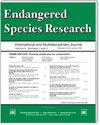Natural history, fisheries, and conservation of the Pacific guitarfish: signs of trouble in Peruvian waters
IF 2.9
2区 环境科学与生态学
Q2 BIODIVERSITY CONSERVATION
引用次数: 0
Abstract
ABSTRACT: This review examines—with a focus on Peru—the distribution, life-history, ecology, fisheries, historic and contemporary cultural importance, commerce, and management of the Pacific guitarfish Pseudobatos planiceps. In the eastern Pacific, Peru represents its most important habitats. The only 2 identified Important Shark and Ray Areas for this species are in Peru for feeding purposes. Other critical habitats are unidentified (e.g. reproductive). Most demographic parameters are unknown, since only length-at-maturity and fecundity have been determined. This species is a mesopredator that feeds on benthic invertebrates but also on Peruvian anchoveta. This trophic plasticity is unique among species within this genus. Globally, Peru has one of the longest species-specific landing datasets (56 yr) and one of the largest catches among countries that report guitarfish landings. This dataset shows a 98% decrease in landings from a peak in 1981 to a low in 2004, while fishing effort increased during this period, suggesting that depletion occurred in the early 1980s. The Pacific guitarfish is the third most landed ray species by artisanal fisheries in Peru, mainly between the central and northern regions. Adults are mainly caught using gillnets and as bycatch in trawling fisheries. Mid-northern Peru has a millennia-old tradition in Pacific guitarfish capture and consumption, and catch is not regulated. Along its distributional range, fisheries in Peru are the main cause of population decline; therefore, there is an urgency to halt this trend to protect the Pacific guitarfish. This review establishes a baseline, identifies information gaps, and provides recommendations to guide research and management for the species.太平洋吉他鱼的自然史、渔业和保护:秘鲁水域的麻烦迹象
摘要:这篇综述以秘鲁为重点,研究了太平洋吉他鱼(Pseudobatos planiceps)的分布、生活史、生态、渔业、历史和当代文化重要性、商业和管理。在东太平洋,秘鲁是吉他鱼最重要的栖息地。秘鲁是该物种仅有的两个已确定的重要鲨鱼和鳐鱼栖息地,用于觅食。其他重要栖息地尚未确定(如繁殖地)。由于仅确定了成熟期长度和繁殖力,因此大多数人口参数尚不清楚。该物种是一种中型食肉动物,以底栖无脊椎动物为食,但也以秘鲁鳀鱼为食。这种营养可塑性在该属物种中是独一无二的。在全球范围内,秘鲁是拥有最长的特定物种上岸数据集(56年)的国家之一,也是报告吉他鱼上岸量最大的国家之一。该数据集显示,上岸量从1981年的高峰下降到2004年的低谷,降幅达98%,而在此期间的捕捞量却有所增加,这表明吉他鱼在20世纪80年代初出现枯竭。太平洋吉他鱼是秘鲁手工渔业上岸量第三大的鳐鱼物种,主要分布在中部和北部地区。成鱼主要使用刺网捕捞,也是拖网渔业的副渔获物。秘鲁中北部的太平洋吉他鱼捕捞和食用传统已有千年之久,捕捞不受管制。在太平洋吉他鱼的分布范围内,秘鲁的渔业是导致其种群数量下降的主要原因;因此,迫切需要阻止这一趋势,以保护太平洋吉他鱼。本综述为该物种的研究和管理确立了基线,确定了信息差距,并提出了指导性建议。
本文章由计算机程序翻译,如有差异,请以英文原文为准。
求助全文
约1分钟内获得全文
求助全文
来源期刊

Endangered Species Research
BIODIVERSITY CONSERVATION-
CiteScore
5.50
自引率
6.50%
发文量
38
审稿时长
31 weeks
期刊介绍:
ESR is international and interdisciplinary. It covers all endangered forms of life on Earth, the threats faced by species and their habitats and the necessary steps that must be undertaken to ensure their conservation. ESR publishes high quality contributions reporting research on all species (and habitats) of conservation concern, whether they be classified as Near Threatened or Threatened (Endangered or Vulnerable) by the International Union for the Conservation of Nature and Natural Resources (IUCN) or highlighted as part of national or regional conservation strategies. Submissions on all aspects of conservation science are welcome.
 求助内容:
求助内容: 应助结果提醒方式:
应助结果提醒方式:


